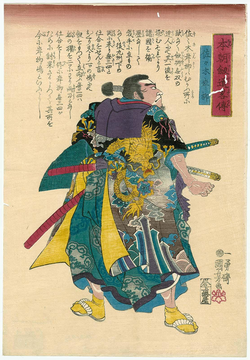Top Qs
Timeline
Chat
Perspective
Sasaki Kojirō
16/17th-century Japanese swordsman; killed in a duel with Miyamoto Musashi From Wikipedia, the free encyclopedia
Remove ads
Sasaki Kojirō (佐々木 小次郎; also known as Ganryū Kojirō; c. 1585 – April 13, 1612), also known by his fighting name Ganryū Kojirō, was a celebrated Japanese swordsman of the late Azuchi–Momoyama and early Edo periods. Born in Fukui Prefecture, he founded the Ganryū school of swordsmanship, specializing in a distinctive long-sword technique most notably the famed Tsubame Gaeshi (“Turning Swallow” cut)[1]. He earned renown across Japan for his flamboyant style and formidable skill, reportedly serving as sword instructor to Hosokawa Tadaoki’s court.
This article includes a list of general references, but it lacks sufficient corresponding inline citations. (April 2011) |
Kojirō is best remembered for his legendary duel against Miyamoto Musashi on Ganryū-jima (also called Funashima) on 13 April 1612, where he was defeated and killed. Despite his loss, Kojirō has been revered in Japanese history and culture; Musashi himself later described Kojirō as the strongest opponent he ever faced.[2][3]


Remove ads
In popular culture
Summarize
Perspective
Like most of the well-known samurai of his era, Sasaki was depicted in several places:
- He plays a central role in the novel, Musashi, by Eiji Yoshikawa. His life is described in a parallel storyline.[4]
- In various film adaptations of his story or that of Miyamoto Musashi. For example, in Zoku Miyamoto Musashi: Ichijōji no kettō (Samurai 2: Duel at Ichijoji Temple; 1955; Director / Screenplay: Hiroshi Inagaki).
- In the manga Vagabond, he plays a central role alongside Musashi and is shown here as deaf.
- Tachibana Ukyo from the computer game Samurai Shodown is modelled after Sasaki, just like the character Haōmaru is modelled after Miyamoto Musashi. His signature technique is also called Tsubame Gaeshi.
- In the visual novel and anime Fate/stay night, Sasaki also played the role of a minor character.
- In the video game Brave Fencer Musashi, the archrival of the protagonist (Musashi) was named after him.
- In the Pokémon series, the original Japanese name for the Flying-type move Aerial Ace is Tsubame Gaeshi. Additionally, the anime characters Jessie and James are known in Japan as Musashi and Kojirō, respectively.
- An ōdachi named the "Washing Pole" is a weapon attainable by the player in the 2011 action RPG Dark Souls and its sequels Dark Souls II and Dark Souls III.
- In the anime and manga "Hajime no Ippo", a reference to Kojiro is made, and his sword movements are repurposed as boxing punches. The first time seen in a fight against the protagonist "Ippo Makunouchi" the user of the "flight of the swallow" is "Kazuki Sanada".
Remove ads
See also
References
Sources
Further reading
Wikiwand - on
Seamless Wikipedia browsing. On steroids.
Remove ads

